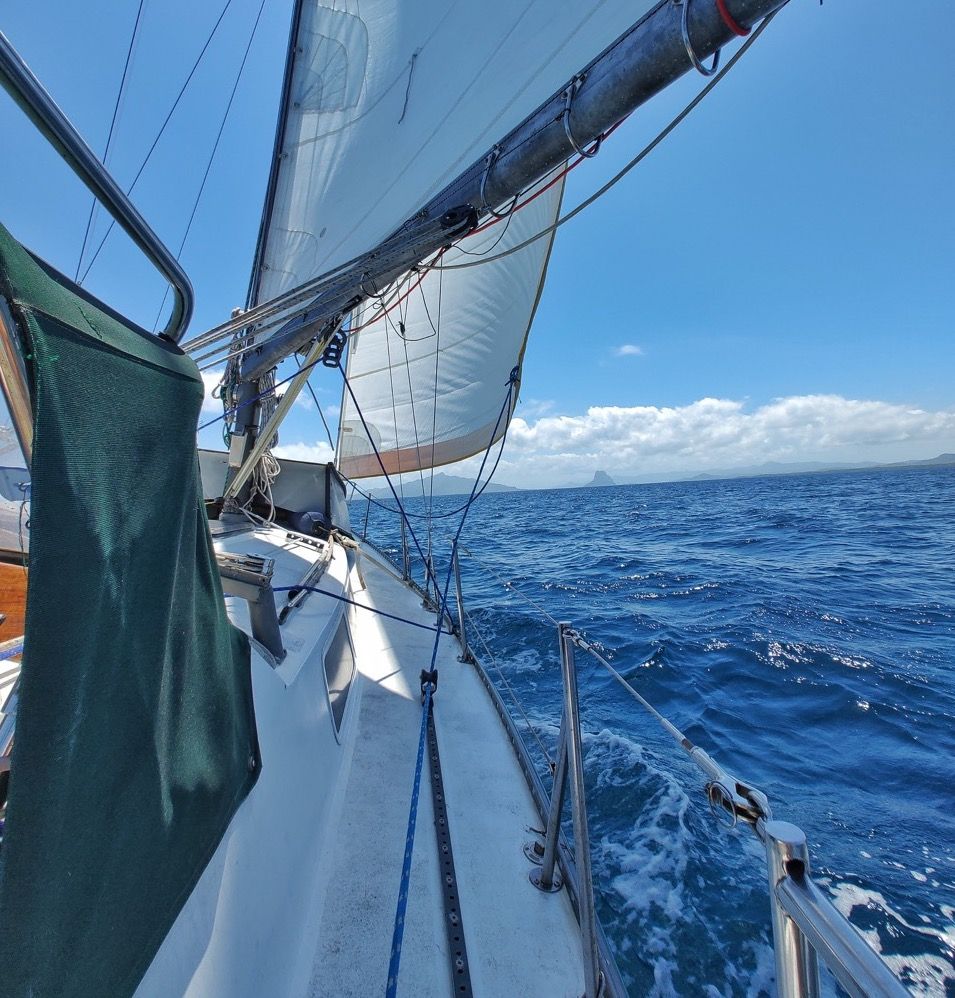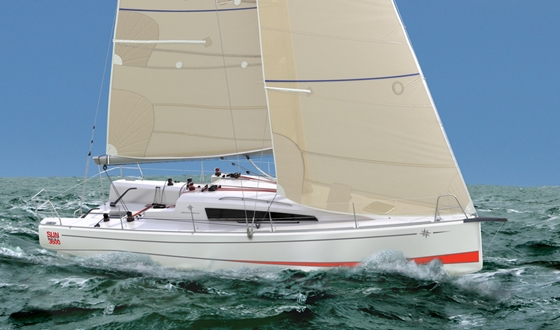Understanding Fatigue & How To Avoid It On Long Distance Sailing Trips
How to avoid sleep deprivation and manage the physical and mental challenges faced during long-distance sea passage.
June 30, 2024
I stood in the cockpit hopping from foot to foot, my foul weather gear wet, my snack pocket empty, and my eyelids heavy. We were hove-to in the lee of Niue, waiting for daylight. After five days at sea both of us wanted nothing more than to pick up a mooring and fall into the bunk, but we didn’t have up-to-date information about the unlit fishing platforms that were rumored to guard the harbor. We didn’t want to make the approach blind, yet another night at sea was the safer bet.

Above: SY Kate Sailing Philippines. Photo by Heather Francis.
Neither Steve nor I had managed more than two consecutive hours of sleep for days. Not to mention the lingering fug of diesel that hung in the cabin thanks to faulty jerry can that had leaked fuel into the bilge on our first day at sea. We were both tired, but Steve had been at the helm for most of the day due to the wind vane not coping with the confused sea state and heavy weather. I sent him below to at least lay down and close his eyes for a few hours.
After two hours of drifting, I gybed. A soft ripping sound, like worn out Velcro pulling apart, yanked me out of a haze. Shining my flashlight up at the reefed mainsail, I saw the top third of the sail dangling from the halyard. I wasn’t paying attention during the gybe and the batten had caught on the running backstay. The sail had ripped from leech to luff right through the last reef point. As I tied the sail to boom, I began to laugh uncontrollably.
Of course, I was tired, but I wasn’t aware how many other factors were affecting my mental state. The constant noise and vibration onboard while sailing in heavy weather, exposure to diesel fumes, being chilled due to my soggy gear, and low blood sugar from not eating properly all compounded my fatigue. It was a hard lesson learned, and a situation I now actively try to avoid.
Sleep Deprivation And Long Distance Sailing
Beyond just feeling a little run down, insufficient sleep affects cognitive skills and physical performance. Reaction time slows and decision making compromised. Compounded over days it is not surprising that breakages and injury result.
People are poor judges of their own levels of fatigue, however there are signs that you need rest. Heavy eyelids, itchy eyes, micro sleeps, and headaches are obvious symptoms of being tired. Preoccupation with a single, minor task or not being able to organise a series of tasks, being less talkative or irritable, heaviness in limbs, and lack of appetite are symptoms that are often not recognized as fatigue.
Getting sleep underway can be extremely difficult so practicing good sleep hygiene should be a priority. Sticking to a consistent watch schedule, especially during long passages, can help you fall into a sleep routine quicker. I like using a sleep mask, particularly during daylight rest periods. Some people also use ear plugs to block out ambient noise. We sleep better in cooler environments, so a fan near the bunk is a must. It is also important to put away the devices. Distracting yourself with a screen is not the same as getting rest.
It is estimated that being awake for 17 straight hours has the same effect on your reaction time and reasoning as having a blood alcohol level of 0.05. At 21 hours awake it is equivalent to 0.08, which is the legal blood alcohol limit in the USA and Canada.
Noise And Vibration
Whether it is the sound of a stiff wind screaming in the rigging, the banging of waves against the hull in a boisterous seaway, or the monotonous thrum of the engine on a windless day out, boating is a noisy affair. Recognised by the WHO, and regulated in many industries including the aviation sector, noise and vibration exposure are serious causes of fatigue.
Noise fatigue isn’t just about damaging your ears, although prolonged exposure to heavy noise can cause irreversible hearing loss. Being in a noisy environment can disrupt concentration, cause muscles to tense, make communication difficult, and sleep sometimes impossible.
Getting away from noise is near impossible while sailing, so it is important to limit exposure. On deck, secure lines, and canvas to prevent flapping and use dampening devices on lines under tension that hum. Down below, make sure items in cupboards are well packed to eliminate annoying knocking and use non-skid to prevent items sliding around. When motoring be aware of how much noise the engine lends to the environment. If working in the engine room while motoring is necessary, always use ear protection. If you want more precise measurements of noise in your environment, try downloading a free sound meter app.
It can be difficult to judge the intensity of sound, so here’s a few everyday noises and their decibel levels. A conversation held at normal volume measures about 60 decibels, a 9.8hp outboard is about 90 dbs, and a thunderclap measures around 120 dbs. With a constant background noise of 80-85 decibels, it can be difficult to communicate with someone more than three feet away who is facing you.
It also important to give yourself a break, so make quiet time a priority onboard. Turn off the music, unplug the devices, eliminate as much ambient noise as possible and let your ears and body recover for an hour or so. This is especially important after a rough and noisy trip.
Fumes And Chemicals
No one wants exposure to harsh chemicals or noxious fumes, but in a small space like a sailboat it is bound to happen. The main culprit is, of course, the in-board propulsion system and the associated fuel, but there are plenty other sources to be aware of. Paints, solvents, cleaning supplies, even heavily perfumed detergents can be irritants.
Keeping a regular engine maintenance schedule will make sure the engine is running efficiently, as well as provide an opportunity to check for leaks or spills in the engine bay. If you must do emergency repairs, try to contain any fuel or oil spills. Keeping a supply of oil absorbs will make clean up quick and safe, and a bottle of degreaser will get up any residual oil or fuel. Make sure to take fresh air breaks.
Heat And Cold
Feeling the wind on your cheek and tasting the saltwater spray in the air is part of the allure of sailing. As important as it is to keep an eye on the weather, it is equally important to monitor personal exposure to the elements. Heat exhaustion and hypothermia don’t just happen in the extreme environments.
Heat exhaustion and heat stroke, sometimes referred to as sun stroke, are two points on the same spectrum of heat-relate illness that also include heat rash and heat cramps. Heat exhaustion is experience first and if left untreated can progress to the life-threatening stage of heat stroke.
Heat Exhaustion
During heat exhaustion the body is unable to cool itself via sweating. Symptoms include headaches, dizziness, muscle cramps, rapid breathing, nausea, and vomiting. If continued exposure to hot, humid conditions persist the bodies mechanism for regulating heat become overwhelmed and the internal body temperature climbs to dangerous levels. At this extreme the body can no longer sweat, speech may become slurred, followed by confusion, aggression, fainting or seizures.
If heat exhaustion is suspected, remove the person from the sun and try to cool them down as quickly as possible. Ice or cool water on the neck, groin, and in the armpits, where blood runs close the skin, is most affective. Rehydration via small sips of water is also important. If signs of heat stroke occur, contact emergency services.
Hypothermia
Getting too cold is just as dangerous as being too hot. Becoming chilled in cold climates is a given, however being wet and exposed to windy conditions, even when sailing in the tropics, can also cause hypothermia.
Mild hypothermia symptoms include shivering and chattering teeth, slow reactions, sleepiness, pale skin, excessive urination, and poor judgement. During medium hypothermia body, shivering decreases, skin can appear blue, there is a further decline in mental functions, and breathing and heart rate slow. If severe hypothermia occurs the body continues to shut down, resulting in a coma or death.
The body losses heat twenty-five times faster when wet, which is why anyone on a boat should be aware of hypothermia. It is important to change out of wet clothes, make sure to have a proper set of wet weather gear for all crew members, and avoid excessive alcohol intake, as it not only impairs sensitivity to cold, but I expands blood vessels and allows heat to leave the skin surface more easily.
Diet And Hydration
Given that many of the factors that cause fatigue are often out of our control, it is particularly important to watch what we consumed when our bodies are under stress. Eating well and staying hydrated will allow your body to better deal with the external stressors, as well as recover and heal faster.
It is common sense to avoid excess alcohol, but it is also important to limit caffeine. Caffeine has a half life of approximate 12 hours, so it can easily keep you wired when you are in need to rest. If coffee is your morning go to, try brewing half decaf or at least avoid coffee after lunch. If you are a tea drinker, swap out the Earl Grey for herbal tea.
Preparing a meal plan and cooking ahead will ensure meals are healthy and easy while underway. Keep in mind that high acid food like tomatoes and pineapple can be difficult to stomach, and overtly spicy dishes enjoyed in port may not go down well at sea. Doing basic prep like peeling and chopping veggies and storing them in zip lock bags in the fridge means less time in the galley underway.
Energy bars and store-bought snacks are easy-to-grab, but they are highly processed and usually packed with sugar and fat. These types of food will give an instant boost; however, they promote blood sugar spikes and crashes, which should be avoided. Try stocking the fridge with carrot and celery sticks, have apples and bananas on hand, and prepare protein heavy snacks like hummus and hard-boiled eggs. If you choose pre-made items check ingredient and nutrient information.
Dehydration
Staying hydrated is also important as it affects concentration, energy levels, sleep wake patterns and even your circulatory system. Signs of poor hydration include being thirsty, feeling lightheaded or dizzy, headaches, dry skin and chapped lips, and dark coloured urine. Be conscious to drink more when sweating heavily to combat fluid loss. Watch children and anyone who is seasick carefully.
While there often is no way of avoiding the very things that can cause fatigue while underway, understanding the causes are will help you reduce exposure and mitigate the unwanted consequences.
Staying out of the sun, avoiding intense and long activities during the hottest parts of the day, taking frequent breaks, drinking plenty water, and wearing sun protective clothing, including a wide brimmed hat, are all ways to prevent over heating.
If you carry extra fuel in jerry cans, be sure secure and store them in a well-ventilated area. This applies to petrol and tanks for the dinghy as well. Store paints and polishes in a dry, well-ventilated compartment. Get rid of tins that have rust or chafe spots to prevent accidental spills. If possible, store metal canisters and tins in a plastic tub, so that any leaks are contained.












